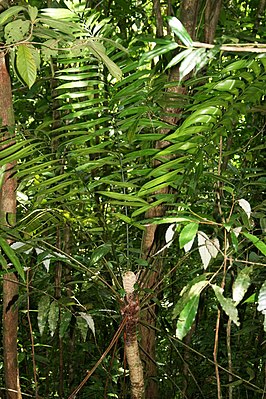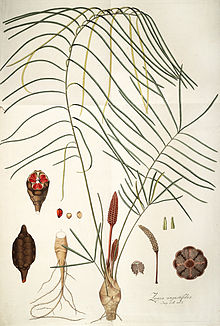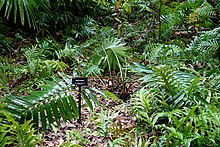Zamia
| Zamia | ||||||||||||
|---|---|---|---|---|---|---|---|---|---|---|---|---|

|
||||||||||||
| Systematics | ||||||||||||
|
||||||||||||
| Scientific name | ||||||||||||
| Zamia | ||||||||||||
| L. |
Zamia is a genus of plants within the order of the cycads (Cycadales).
description





Vegetative characteristics
The trunks usually form underground tubers without pronounced wood tissue. Some species form an above-ground trunk that can be 4 meters and more high. Three species have a strongly derived growth form: Zamia pseudoparasitica is an epiphyte on tree trunks and anchors itself with its roots . The other two, Zamia cremnophila and an undescribed species, grow on sandstone rocks and hold their roots in small crevices. Species with aboveground stems soon shed the leaf bases and cataphylls and then have a bare epidermis . In the species that grow in the rainforest, the trunk is soon covered with epiphytes.
The leaves are simply pinnate, long or short, upright, horizontal or hanging and very variable. Developing leaves are green, bronze, red, or purple. The petiole and rachis are unarmed or have sharp spines. The leaflets are stiff and leathery or soft and paper-like, the surface smooth, furrowed or ribbed, shiny or dull, the leaf margin entire, serrated or serrated. Zamia variegata has variegated leaves.
Generative characteristics
The female cones are very different depending on the species. The size ranges from 7.5 cm to 46 cm. The color of the sarcotesta ranges from yellow to orange and pink to red. Most species have no seed dormancy. The cones take 6 to 14 months to ripen and the growing seeds force the sporophylls apart. As long as immature, the Sarcotesta is inconspicuous. When the cone breaks open, the seeds quickly stop ripening and the sarcotesta becomes colored and soft. As far as investigated, the species are all pollinated by insects ( entomophilia ). The seeds may be spread by birds and rodents.
Male cones are less variable than the female ones. They are small, grow and pass quickly. In some tropical species, the many cones ripen one after the other, so that the pollen production takes a long time.
The chromosome numbers are 2n = 16-18, 21-28.
Occurrence and endangerment
The Zamia species have the broadest range of cycads in terms of locations. There are species in the rainforest, savannah , on stable coastal dunes, tidal swamps, and deserts, from sea level to altitudes of 2500 meters.
Many species are endangered due to their small area and increasing land use.
Systematics and distribution
The genus Zamia was by Carl Linnaeus in 1763 set up . The type species is Zamia pumila . Synonyms for Zamia L. are: Palmifolium Kuntze nom. superfl., Palma-filix Adans. nom. rej., Chigua D.W.Stev. , Aulacophyllum rule .
Zamia forms with the genus Microcyca the tribe Zamieae within the subfamily Zamioideae in the family Zamiaceae . Since Lindstrom 2009 the previous two species belong to the genus Chigua D.W.Stev. under the name Zamia restrepoi (DWStev.) A. Lindstr. also back to the genus Zamia .
The genus Zamia occurs in the Neotropic , but as one of the few cycads on both sides of the equator. The northern limit of the distribution lies in Georgia and Florida, the area extends over Mexico, the West Indies and Central America to South America to northern Chile, Bolivia and Brazil. It reaches the greatest biodiversity in Panama, Colombia and Cuba. There were 22 species in Mexico in 2009.
Whitelock lists 60 Zamia species in 2002 . After that many more species were first described. There are about 79 types of Zamia (as of 2018):
- Zamia acuminata Oerst. ex Dyer : This endemic occurs only in southern Costa Rica .
- Zamia amazonum D.W.Stev. : The distribution area extends from southern Venezuela to Peru .
- Zamia amplifolia mast. : This endemic occurs only in north-western Colombia .
- Zamia angustifolia Jacq. (Syn .: Zamia angustissima Miq. ): It occurs only on the Caribbean islands of the Bahamas and eastern Cuba.
- Zamia boliviana (Brongn.) A.DC. : The distribution area extends from Bolivia to the Brazilian state of Mato Grosso .
- Zamia chigua Seem. : This endemic occurs only in western Colombia.
- Zamia cremnophila Vovides, Schutzman & Dehgan : It occurs only in the Mexican state of Tabasco .
- Zamia cunaria Dressler & DWStev. : It only occurs in Panama .
- Zamia decumbens Calonje, Meerman, MPGriff. & Hoese : It wasfirst described in Belize in 2009.
- Zamia disodon D.W.Stev. & Sabato : It was first described in 2001 from Colombia.
- Zamia dressleri D.W.Stev. : It only occurs in Panama.
- Zamia elegantissima Schutzman, Vovides & RSAdams : It only occurs in Panama.
- Zamia encephalartoides D.W.Stev. : It was first described in 2001 from north-western Colombia.
- Zamia erosa O.F. Cook & GNCollins (Syn .: Zamia amblyphyllidia D.W.Stev. ): It occurs only in the Greater Antilles in Cuba , Jamaica and Puerto Rico .
- Zamia fairchildiana L.D. Gómez : The homeland stretches from eastern Costa Rica to western Panama.
- Zamia fischeri Miq. : The home is Mexico.
- Zamia furfuracea L. f. : It only occurs in the Mexican state of Veracruz .
- Zamia gentryi Dodson : The home is Ecuador.
- Zamia gomeziana R.H. Acuña : It was first described in 2010 from north-eastern Costa Rica.
- Zamia grijalvensis Pérez-Farr., Vovides & Mart.-Camilo : It was first described in 2012 from the Mexican state of Chiapas.
- Zamia hamannii A.S. Taylor, JLHaynes & Holzman : It was first described from Panama in 2008.
- Zamia herrerae Calderón & Standl. : It occurs from Mexico to Guatemala .
- Zamia huilensis Calonje, HEEsquivel & DWStev. : It was first described from Panama in 2012.
- Zamia hymenophyllidia D.W.Stev. : It was first described in 2001 and occurs from southeastern Colombia to northern Peru .
- Zamia imperialis A.S. Taylor, JLHaynes & Holzman : It was first described from Panama in 2008.
- Zamia incognita A. Lindstr. & Idarraga : It was first described from Colombia in 2009.
- Zamia inermis Vovides, JDRees & Vázq.Torres : It only occurs in the Mexican state of Veracruz.
- Zamia integrifolia L.f. (Syn .: Zamia floridana A.DC. ): It occurs from southeast Georgia to Florida , on the Bahamas, in Cuba and on the Cayman Islands .
- Zamia ipetiensis D.W.Stev. : It only occurs in Panama.
- Zamia × katzeriana (rule) E.Rettig = Zamia loddigesii × Zamia verschaffeltii
- Zamia lacandona Schutzman & Vovides : It only occurs in the Mexican state of Chiapas.
- Zamia lecointei Ducke (Syn .: Zamia jirijirimensis R.E.Schult. ): The range extends from southern Venezuela to northern Peru and Brazil .
- Zamia lindenii rule ex André : The range extends from western Ecuador to northwestern Peru.
- Zamia Lindleyi Warsz. ex A.Dietr. : It only occurs in Panama.
- Zamia loddigesii Miq. (Syn .: Zamia lawsoniana Dyer ): It occurs from Mexico to Belize .
- Zamia lucayana Britton : It only occurs in the Bahamas.
- Zamia macrochiera D.W.Stev. : It was first described in 2004 from northern Peru.
- Zamia manicata Linden ex rule : The home is southern Panama and northwestern Colombia.
- Zamia meermanii Calonje : It was first described from Belize in 2009.
- Zamia melanorrhachis D.W.Stev. : It was first described in 2001 from Colombia.
- Zamia montana A. Brown : It occurs only in northern Colombia.
- Zamia monticola Chamb. : The home is Guatemala .
- Zamia muricata Willd. : The homeland is Colombia and northern Venezuela.
- Zamia nana A. Lindstr. : It was first described from Panama in 2013.
- Zamia nesophila A.S. Taylor, JLHaynes & Holzman : It was first described from Panama in 2008.
- Zamia neurophyllidia D.W.Stev. : The home is southern Nicaragua , Costa Rica and Panama.
- Zamia obliqua A. Braun : The homeland is north-western Colombia and southern Panama.
- Zamia oligodonta Calderón & DWStev. : It only occurs in Colombia.
- Zamia onan-reyesii C. Nelson & Sandoval : It wasfirst describedin 2008 from Honduras .
- Zamia oreillyi C.Nelson : It was first described from Honduras of 2007.
- Zamia paucifoliolata Calonje : It was first described from Colombia in 2018.
- Zamia paucijuga Wieland : The home is southwest Mexico.
- Zamia poeppigiana Mart. & Eichler : The home is Peru and Brazil.
- Zamia portoricensis Urb. : This endemic occurs only in western Puerto Rico.
- Zamia prasina W.Bull (Syn .: Zamia polymorpha D.W.Stev., A.Moretti & Vázq.Torres ): The homeland is southeastern Mexico to Belize .
- Zamia pseudomonticola L.D.Gómez : It is native to western Costa Rica and southwestern Panama.
- Zamia pseudoparasitica J. Yates : This endemic occurs only in northern Panama.
- Zamia pumila L .: It occurs in the Greater Antilles in Cuba, the Dominican Republic , Jamaica and Puerto Rico .
- Zamia purpurea Vovides, JDRees & Vázq.Torres : The home is the Mexican states of Veracruz and Oaxaca .
- Zamia pygmaea Sims (Syn .: Zamia pumila subsp. Pygmaea (Sims) Eckenw. , Zamia kickxii Miq. ): This endemic occurs only in western Cuba.
- Zamia pyrophylla Calonje, DWStev. & A. Lindstr. : It was first described in 2010 from north-western Colombia.
- Zamia restrepoi (DWStev.) A. Lindstr. (Syn .: Chigua restrepoi D.W.Stev. , Chigua bernalii D.W.Stev. ): This endemic occurs only in north-western Colombia.
- Zamia roezlii rule ex Linden : It occurs in Colombia and Ecuador.
- Zamia sandovalii C.Nelson : It was first described from Honduras of 2007.
- Zamia skinneri Warsz. ex A.Dietr. : This endemic occurs only in northern Panama.
- Zamia soconuscensis Schutzman, Vovides & Dehgan : It occurs only in the Mexican state of Chiapas.
- Zamia spartea A.DC. : It only occurs in the Mexican state of Oaxaca.
- Zamia standleyi Schutzman : It occurs in Guatemala and Honduras .
- Zamia stevensonii A.S. Taylor & Holzman : It was first described from Panama in 2012.
- Zamia stricta Miq. : This endemic occurs only in eastern Cuba.
- Zamia tolimensis Calonje, HEEsquivel & DWStev. : It wasfirst describedin 2011 from the Colombian province of Tolima .
- Zamia tuerckheimii Donn.Sm. : The home is Guatemala.
- Zamia ulei Dammer (Syn .: Zamia cupatiensis Ducke ): It is common in tropical South America.
- Zamia urep B. Walln. : It occurs only in the Peruvian region of Huánuco .
- Zamia variegata Warsz. : It occurs from the Mexican state of Chiapas via Belize to Guatemala.
- Zamia vasquezii D.W.Stev., Sabato & De Luca : It occurs only in the Mexican state of Veracruz.
- Zamia verschaffeltii Miq. (Syn .: Zamia splendens Schutzman ): It occurs in the Mexican states of Veracruz, Tabasco and Chiapas.
- Zamia wallisii H.J. Veitch : It occurs only in the Colombian province of Antioquia .
use
Zamia species are relatively seldom used as ornamental plants compared to other cycads . One reason is seen in their tropical distribution, in the moderate latitudes they can almost only be cultivated in greenhouses.
literature
- Loran M. Whitelock: The Cycads. Timber Press, Portland OR 2002, ISBN 0-88192-522-5 , pp. 288 f.
- AJ Lindstrom: Typification of some species names in Zamia L. (Zamiaceae), with an assessment of the status of Chigua D. Stev. In: Taxon , Volume 58, Issue 1, 2009, pp. 265-270.
- R. Osborne, MA Calonje, KD Hill, L. Stanberg, DW Stevenson: The world list of cycads. Proceedings of the 8th International Conference on Cycad Biology (CYCAD 2008). Panama City, Panama, January 2008. In: Memoirs of the New York Botanical Garden , Volume 106, 2012, pp. 480-510.
- Fernando Nicolalde-Morejón, Andrew P. Vovides, Dennis W. Stevenson: Taxonomic revision of Zamia in Mega-Mexico. In: Brittonia , Volume 61, Issue 4, 2009, pp. 301-335. JSTOR 40648244
Individual evidence
- ↑ Species Plantarum . 2nd edition, Volume 2, 1763, p. 1659 ( PDF )
- ↑ a b c d e f g h i j k l m n o p q r s t u v w x y z aa ab ac ad ae af ag ah ai aj ak al am an ao ap aq ar as at au av aw ax ay az ba bb bc bd be bf bg bh bi bj bk bl bm bn bo bp bq br bs bt bu bv bw bx by Rafaël Govaerts (Ed.): Zamia. In: World Checklist of Selected Plant Families (WCSP) - The Board of Trustees of the Royal Botanic Gardens, Kew . Retrieved May 5, 2019.
- ↑ AJ Lindstrom: typification of some species names in Zamia L. (Zamiaceae), with on assessment of the status of Chigua D. Stev. In: Taxon , Volume 58, Issue 1, 2009, pp. 265-270.
- ↑ a b c M. Calonje, DW Stevenson, R. Osborne: The World List of Cycads , online edition, 2013-2019. cycadlist.org .
- ↑ Loran M. Whitelock: The Cycads. 2002, pp. 290-344.











